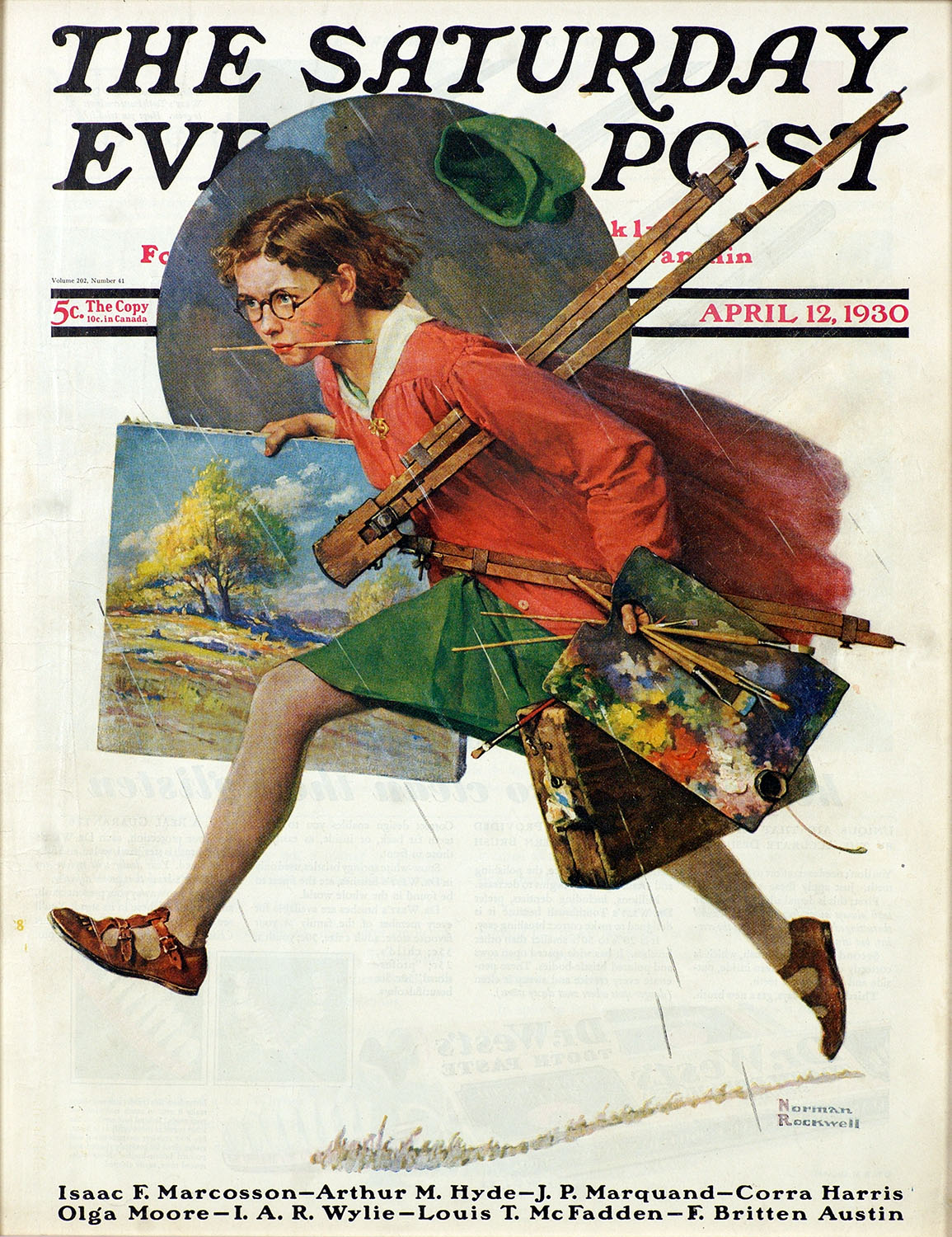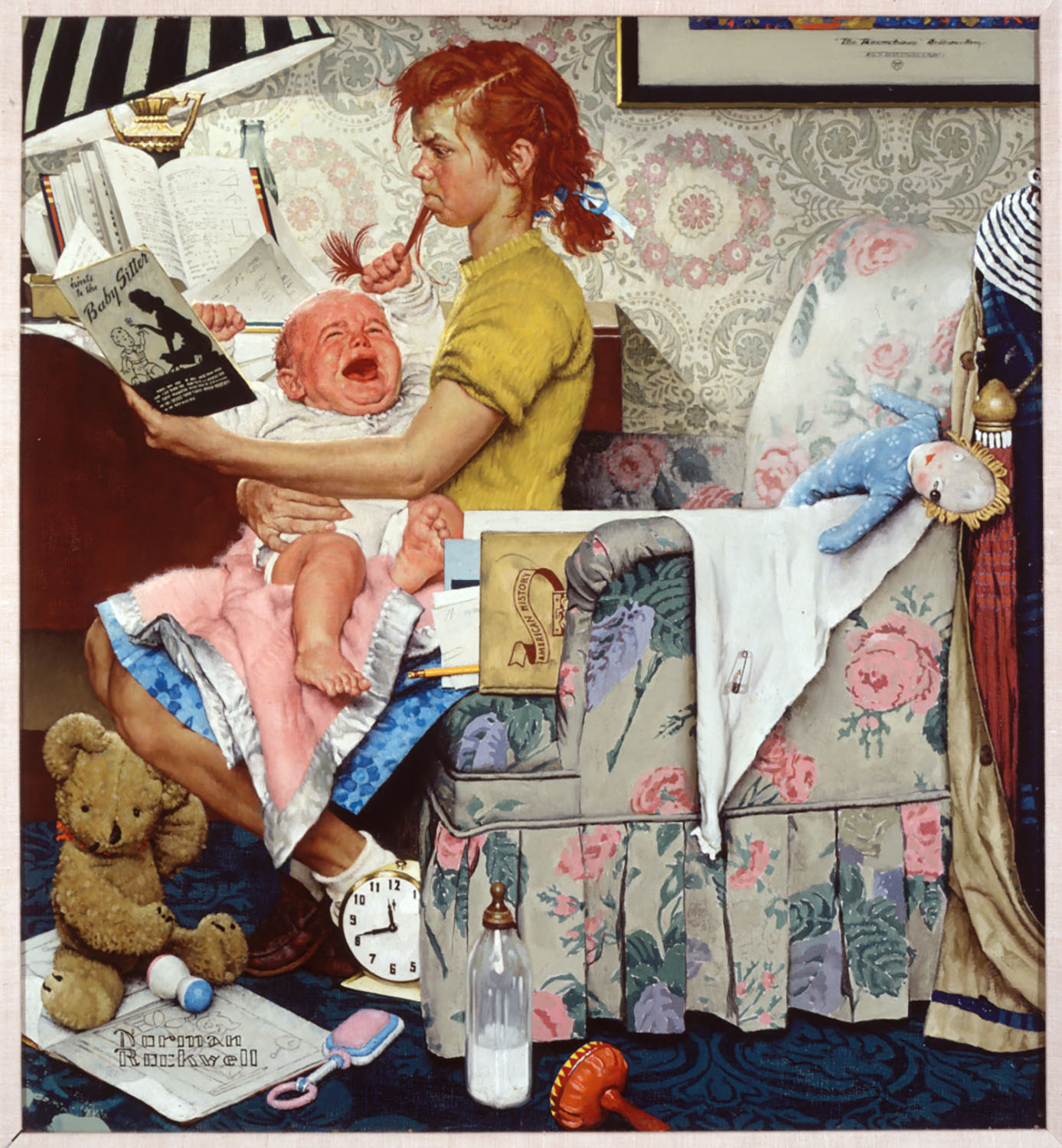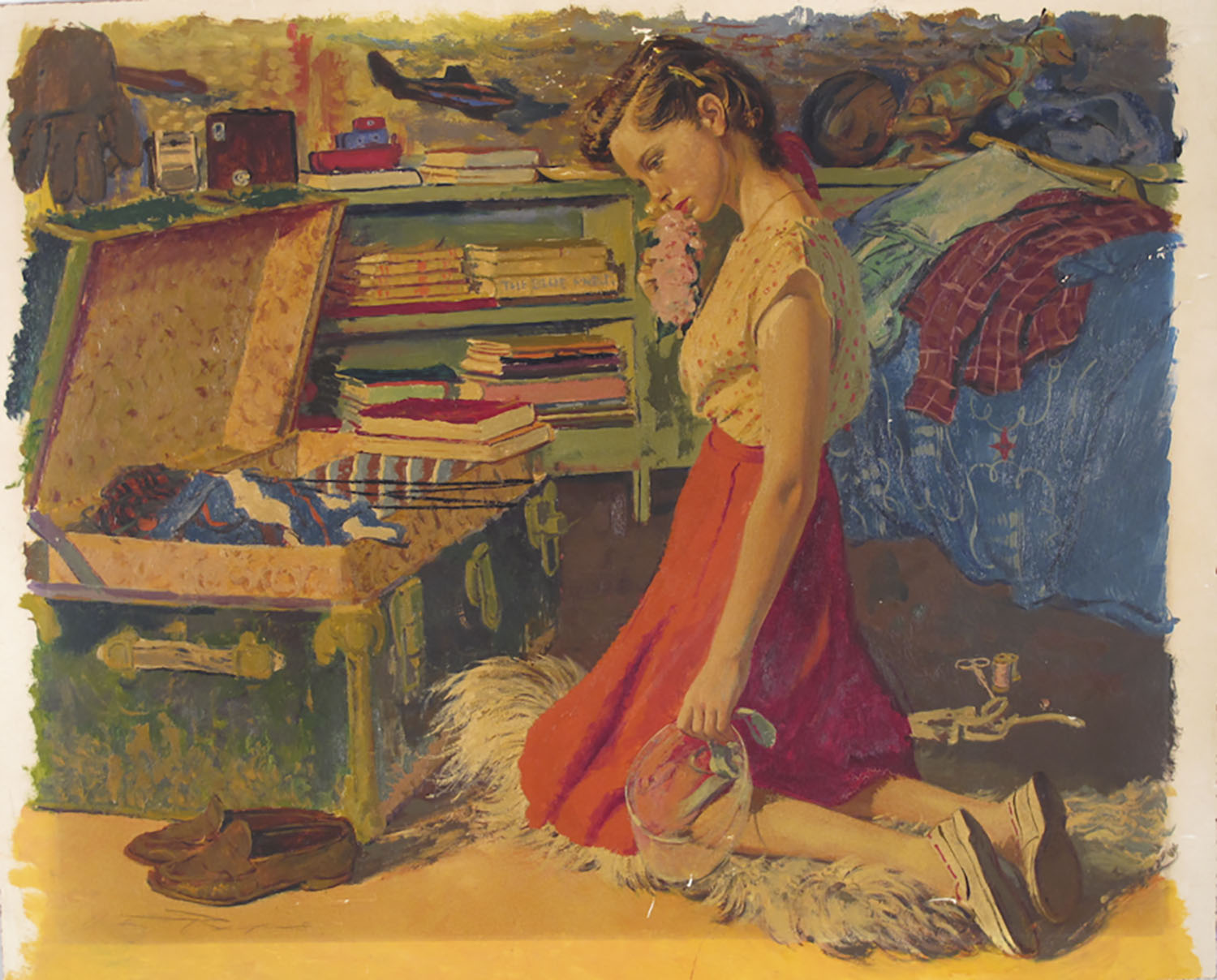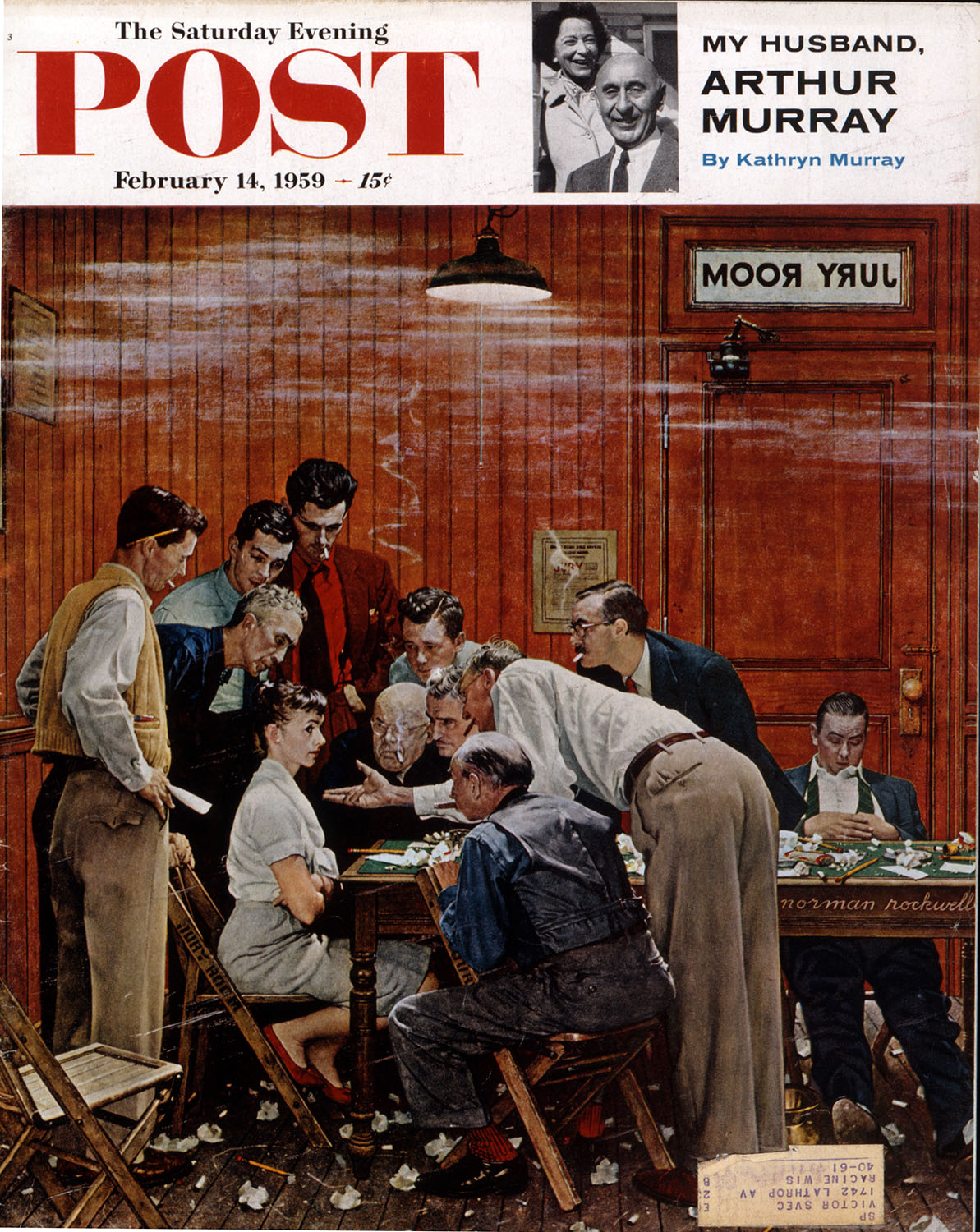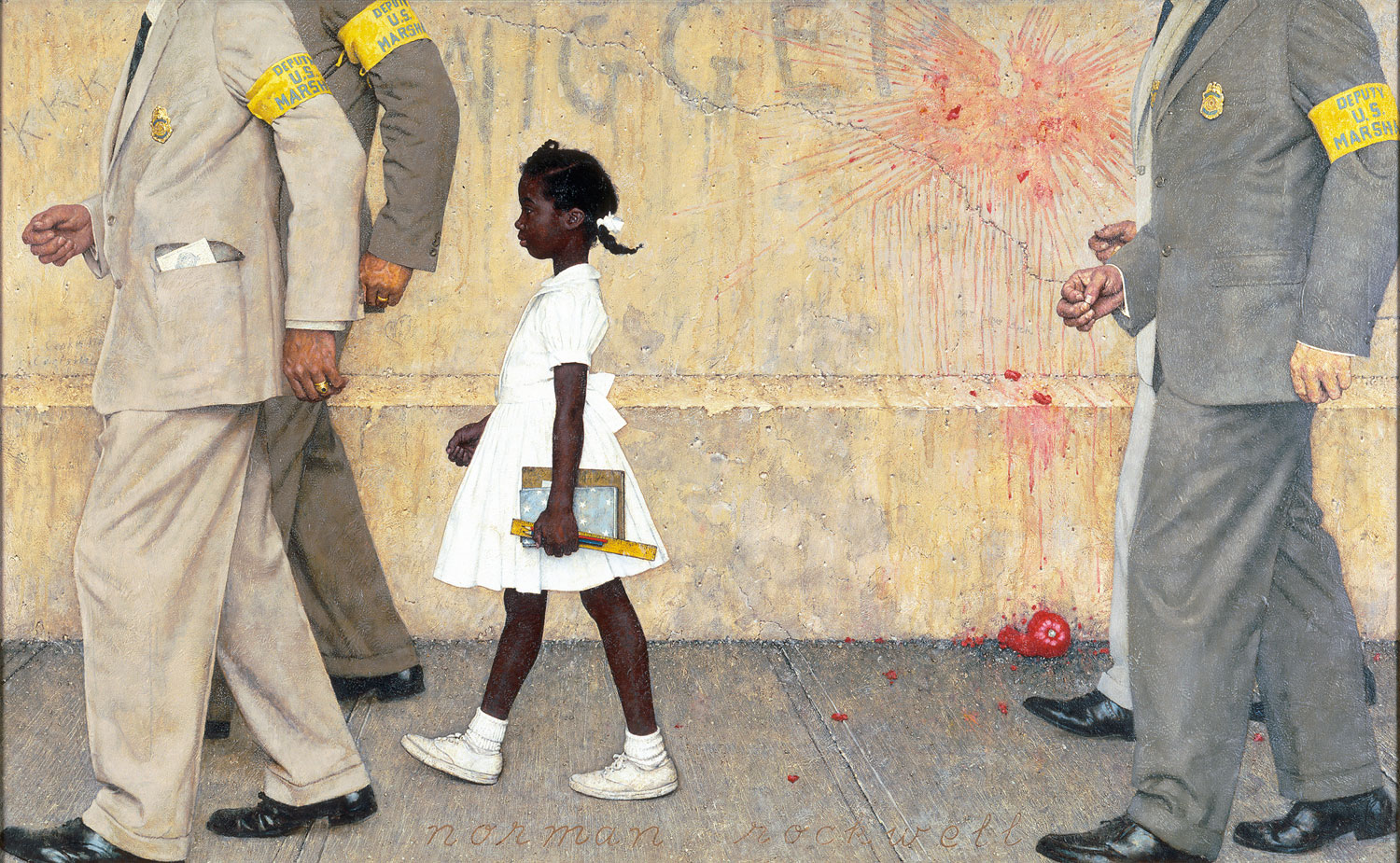Quick Pics: Womanpower- Weeks of 5/4/2020-5/11/2020
Overview - Womanpower
Wet Paint (1930)
Big Idea
The details in this image tell a story about a young woman fully engaged in her art making. We get the sense she is spending time doing something she loves to do.
Notice and Wonder
- She leans forward, pencil between her teeth and with her feet barely touching the ground.
- She carries a canvas, paintbox, a wet palette of paint, a foldable easel, and lots of brushes. Her paintbox is hastily closed with what looks like a rag popping out.
- She is moving so quickly that her hat has come off!
- Look at the sky. Might she be trying to outrun a storm?
- Is it possible that the weather was lovely when she began to paint, she was fully absorbed in her work, and then it suddenly began to rain?
Fun Facts
- This is a subject that Norman Rockwell would have been very familiar with, because as a young man, he attended art school at the Art Students League in New York, where he studied painting, drawing, and illustration.
- Art was his true love and passion throughout his life, and he continued to work at it and perfect his skills for about seventy years.
- Norman Rockwell loved to paint but he did not paint out of doors very often. He generally worked in his studio from sketches and photographs of his models. When he traveled for pleasure or business, he often brought along a paint box just like the one you see here, and that allowed him to continue making art no matter where he was. It was stuffed with oil paints, charcoal, rags, a palette, and other supplies.
What you can do!
- Notice what you are doing and who you are with when you feel most alive and fully engaged. This image celebrates how wonderful it feels to be fully engaged, and it invites us to reflect on our own interests and those of the people in our class, community, family. How can we best support each other to make time and space for pursuing our greatest interests?
The Babysitter (1947)
Big Idea
Persisting and trying many strategies is not easy, but it is a way to learn new skills. Learning new skills is challenging, humorous and stressful at times. That is to be expected.
Notice and Wonder
- Move your eye around the painting. What do you notice?
- There are books, toys, a teddy bear, and rattles, a baby bottle, a baby blanket which begin to tell the story.
- If you could listen in, what might you hear?
- Notice her school books are scattered on the table and tucked into her chair.
- What is she reading? (It is an instructional book on how to be a babysitter!)
- Why might there be a clock on the floor? Do you think she’s looking forward to the return of the baby’s parents from their time away?
- How do you think the girl feels? How do you think the baby feels? How would you feel in this situation if you were the babysitter and what might you try to calm the baby down?
Fun Facts
- Find the top of the glass bottle on the table in this picture. Rockwell loved Coca Cola and often drank it as an afternoon treat; he also offered it to his young models when they posed, and they really enjoyed that.
- This painting was given by Norman Rockwell to an elementary school class at the Elihu B. Taft Elementary School in 1947 in honor of Allison Pooley, a little girl who passed away of leukemia.
- The class had visited Rockwell’s Arlington, Vermont studio on a special trip, and he gave each student an autograph and did an art demonstration. Allison enjoyed her visit to Rockwell’s studio, the children in the class raised $48 to purchase a picture by Rockwell to hang in her honor, but he was so touched that he donated this piece. The school still owns the picture today.
- Another fun fact - in 1947, diapers were made of cloth, which had to be washed, rather than disposable paper diapers that are thrown away. You can see the baby wearing one such diaper, attached with a pin, in this picture.
What you can do!
What are things you do that require determination, trying different strategies, and being brave? Draw a picture or make a photo that tells your story of persistence, determination, and learning new skills.
I Will Never Let You Go (1948)
Big Ideas
This painting, I’ll Never Leave You, was painted by Austin Briggs in 1948. He was a contemporary of Norman Rockwells and had his own style.
Austin Briggs painted the young woman reflecting, looking away from the viewer. This was an unusual technique at the time and creates an invitation for us to look closely at her and also make sense of her surroundings. Austin Briggs created this image to invite reflection about memory, objects that stir memories and the connections between past, present and future.
Notice and Wonder
- What story does this image tell?
- What are the clues in the image which point to what the young woman might be thinking about?
- Whose trunk might this be and what might be inside?
- Look around the young woman’s room - what do you see? (Childhood toys, books, a ping-pong paddle, a radio, clothing on the bed).
- Notice the scissor and thread on the floor. Is the young woman mending? Or might the scissors and thread symbolize her role as a caretaker of memories?
- How does Austin Briggs use color to call attention to the young woman? He used a technique called color blocking. The young woman is the brightest. Her skirt is red and her red hair tie brings our eyes up. Rockwell and he both used red to move our eyes around the image.
- Briggs inspires empathy for a young person who explores the depths of memory through the objects found in a storage trunk. In this composition, large geometric color blocks surround and call attention to the main subject of the work.
Fun Facts
- Austin Briggs was a popular illustrator who illustrated for American magazines in the mid-twentieth century, just like Norman Rockwell. He and Norman Rockwell were part of an art correspondence course institution called The Famous Artist School which was launched in 1948, the same year this painting was completed.
- Empathy, or the ability to “feel” the emotions of his characters, was important to Briggs, and also an important part of visual storytelling.
- The spirit of an event, according to Austin Briggs, was more important than the fact. “The illustrator must not only master his craft but must live, pile up experiences, and become aware of the infinite aspects of our world,” he said. “He must distill everything…to create characters and situations that communicate to viewers; he must communicate a mood he has felt and express his enthusiasm for his characters and situations.”
What you can do!
- What do you reflect about in your quiet moments? Are there objects in your life which stir emotions in you about the past? What are they and how do they help you think about the present and the future?
- Over generations matriarchs within families often hold and share family memories and narratives which shape family identity. Is there a person in your family who keeps track of family history? Are there objects which go with family stories? What are they? And what are the stories you will want to remember about your family?
- Draw or write about a family story and include an object that symbolizes that.
The Jury (The Holdout) (1959)
Big Idea
Have you ever felt strongly about something even though others did not agree with you?
This image tells a story about having an opinion, weighing evidence, and possibly sticking to our own ideas even while also listening to other viewpoints. Taking responsibility for learning and forming opinions based on evidence, not just popular opinion, is part of our responsibility as Americans. All citizens have the right to an opinion and vote, and they have a civic responsibility to participate as jurors in the court system.
Notice and Wonder
- Notice the close proximity of jurors to each other.
- What are the clues that place this image in time? It was painted in 1959, over 60 years ago. What do you notice about the characters’ haircuts, dress?
- Many characters are smoking which is something that would not happen today in a courtroom.
- Rockwell places himself, as a curious observer, right behind the woman. He is wearing a blue shirt. Where the other men surrounding the woman seem to be trying to convince her of their opinion, Rockwell presents himself as a curious and respectful observer watching the situation unfold.
Fun Facts
- To use so much red in the background is unusual for Rockwell. There is an emotionally charged story this image tells which the red brings out. The jurors have strong opinions.
- Do you think the woman’s red shoes are a sign that she is a strong and independent thinker? Norman Rockwell added details to his images with great intention and purpose.
- Taking part in the democratic process by participating on a jury is a civic responsibility for all citizens of voting age. Generally, after hearing the facts of a court case, a group of six to twelve men and women serving as trial jurors discuss the facts in a jury room, and must decide the outcome of the case and the fate of the defendant. All jurors must agree, otherwise the case will result in a hung jury, when no decision is reached.
- Notice the man who is sleeping! He provides visual interest because he is behaving differently than the rest.
- Rockwell often changed his signature. It appears in different places; sometimes he makes it part of the picture as he did in this case by writing it onto the side of the table.
- Norman Rockwell was so famous by the time he created this image, he only partially signed the image knowing people would recognize his image and the first part of his name.
What you can do!
- Think about a time when you had a strong opinion. What was it and how did you share it with others? Notice the people in your life with strong opinions. Invite them to share their perspective and take some time to both share your thinking and understand theirs.
The Problem We All Live With (1964)
Big Idea
Demonstrating bravery and strength in the face of injustice can change the world.
Notice and Wonder
- What do you see in this painting? Where might the little girl be going, and how do you know? Who surrounds her, and why might they be there?
- Ruby is the main character. Federal marshals surround her but we cannot see their heads. Ruby is forward in the painting. She is in a white dress, pristine, organized, ready for anything.
- The marshals are in sync. They are protecting her but we can see it is not an easy job. What does the writing on the wall tell us? The tomato spatter? We have a sense from the background and Ruby’s steadfast gaze, posture and stride that she is undeterred.
Important Facts
- Norman Rockwell’s painting, The Problem We All Live With, is based upon an actual event, when six-year-old Ruby Bridges was escorted by U.S. marshals to her first day at an all-white elementary school in New Orleans, Louisiana, in 1960. The school, and all others in the United States, were ordered to proceed with school desegregation, allowing white children and black children to be educated together.
- On the first day of school and each day for a year, Ruby was picked up at her home and brought to the school by four United States Marshals, who were there to protect her from protesters outside. Even though we can’t see the people protesting Ruby’s attendance, do you see signs that they are there? (The tomato spatter and writing on the wall are evidence of the angry crowd facing Ruby).
- Ruby’s teacher, Barbara Henry, was brought to Louisiana from Boston to work with her. The two remain good friends today, sixty years later.
- Ruby, Ruby’s family, her teacher, the U.S. Marshalls and many others led change through very brave actions during the civil rights movement of the 1960s.
What you can do!
- Notice what is not fair in your community and ask questions. Stand up for injustice when you see it and be willing to take risks for the greater good and equity. Do not be a bystander.
Image Resources
Wet Paint (1930)
The Babysitter
I Will Never Let You Go
The Jury (The Hold Out) (1959)
The Problem We All Live With (1964)
Image Credits:
Girl Running With Wet Canvas (Wet Paint), 1930
Norman Rockwell (1894 - 1978)
Oil on canvas
Cover illustration for The Saturday Evening Post, April 12, 1930
© 1930 SEPS: Curtis Licensing, Indianapolis, IN
Norman Rockwell (1894 - 1978)
Oil on canvas
Cover illustration for The Saturday Evening Post, November 8, 1947
© 1947 SEPS: Curtis Licensing, Indianapolis, IN
Austin Briggs (1908 - 1973)
Casein paint on board
Story illustration for American Magazine, 1948
Gift of Loretta Knight
Norman Rockwell Museum Collection
Norman Rockwell (1894 - 1978)
Oil on canvas
Cover illustration for The Saturday Evening Post, February 14, 1959
© 1959 SEPS: Curtis Licensing, Indianapolis, IN
- Grade
- K-6
- Theme
- Quick Pics
- Length
- Each Quick Pic activity is about 5-10 minutes in duration, with each being taught one image per day over a week.
- Discipline
- Social Studies, Language Arts: Speaking and Listening, Art
- Vocabulary
- Woman, Women, Girl, Girls, Babysitter, Empowered
Standards
This curriculum meets the standards listed below. Look for more details on these standards please visit: ELA and Math Standards, Social Studies Standards, Visual Arts Standards.
- CCSS.ELA-Literacy.CCRA.L.1
- Demonstrate command of the conventions of standard English grammar and usage when writing or speaking.
- CCSS.ELA-Literacy.CCRA.L.2
- Demonstrate command of the conventions of standard English capitalization, punctuation, and spelling when writing.
- CCSS.ELA-Literacy.CCRA.L.3
- Apply knowledge of language to understand how language functions in different contexts, to make effective choices for meaning or style, and to comprehend more fully when reading or listening.
- CCSS.ELA-Literacy.CCRA.L.4
- Determine or clarify the meaning of unknown and multiple-meaning words and phrases by using context clues, analyzing meaningful word parts, and consulting general and specialized reference materials, as appropriate.
- CCSS.ELA-Literacy.CCRA.L.5
- Demonstrate understanding of figurative language, word relationships, and nuances in word meanings.
- CCSS.ELA-Literacy.CCRA.L.6
- Acquire and use accurately a range of general academic and domain-specific words and phrases sufficient for reading, writing, speaking, and listening at the college and career readiness level; demonstrate independence in gathering vocabulary knowledge when encountering an unknown term important to comprehension or expression.
- CCSS.ELA-Literacy.CCRA.SL.1
- Prepare for and participate effectively in a range of conversations and collaborations with diverse partners, building on others' ideas and expressing their own clearly and persuasively.
- CCSS.ELA-Literacy.CCRA.SL.2
- Integrate and evaluate information presented in diverse media and formats, including visually, quantitatively, and orally.
- CCSS.ELA-Literacy.CCRA.SL.3
- Evaluate a speaker's point of view, reasoning, and use of evidence and rhetoric.
- CCSS.ELA-Literacy.CCRA.SL.4
- Present information, findings, and supporting evidence such that listeners can follow the line of reasoning and the organization, development, and style are appropriate to task, purpose, and audience.
- CCSS.ELA-Literacy.CCRA.SL.5
- Make strategic use of digital media and visual displays of data to express information and enhance understanding of presentations.
- CCSS.ELA-Literacy.CCRA.SL.6
- Adapt speech to a variety of contexts and communicative tasks, demonstrating command of formal English when indicated or appropriate.
